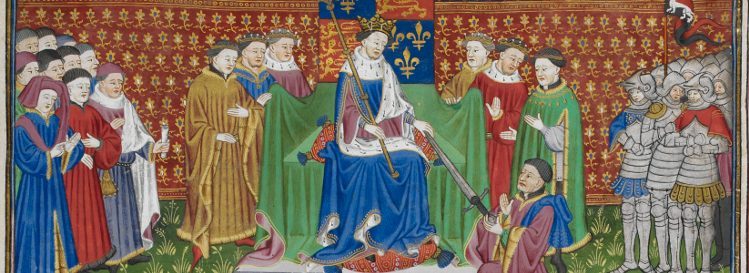The scandal in 1441 of the arrest and and conviction of Eleanor Cobham, Duchess of Gloucester, of consulting astrologers and envisaging the death of the King created a sensation, since her husband, Duke Humphrey was at the time the heir presumptive to the crown. It called to the fore the need for a suitable marriage for the King. At the age of twenty Henry was well and truly of marriagable age. It was expected that such a union should bring England and the crown considerable tangible advantages.
Charles, Duke of Orléans, who had been a prisoner in England after Agincourt until 1440, suggested an alliance with a daughter of the Count of Armagnac, to whom he was himself related. Count John IV was anxious for a strong alliance to secure his lands against the power of Charles VII. Consequently an embassy arrived at Windsor in May 1442 proposing such a marriage. Armagnac lands bordered the English possessions of Guienne (Gascony) and might act as a much needed buffer for the endangered province.
Henry himself favoured the idea. An English embassy was charged with the mission in the presence of the King, and Henry sent after them instructions to report on all three daughters of the count. An artist, Master Hans, was dispatched to "portray the three daughters in their kirtles simple, and their visages like as you see their statute and their beauty and colour of skin and their countenances with all manner of features." As was to be expected, Henry was taking an active interest in the choice of his future bride. The portraits were to be sent back "in all haste....unto the King, and he to appoint and sign which he likes; and thereupon to send you word how you shall be governed." The portraits were never to be completed. Master Hans had made only one when the cold in January 1443 froze his paints. The Armagnac project failed, because with Charles VII hovering for an excuse to invade and seize the lands of his mistrusted vassal, Count John himself no longer dared not conclude an alliance with the English.
At home the news delighted Cardinal Beaufort and the party in favour of some sort of peace settlement. They would now propose a marriage to a suitable French princess of their own choosing, and their choice fell on Margaret, the daughter of René, Duke of Anjou, of Lorraine and Bar, titular King of Jerusalem and of Sicily, brother-in-law to Charles VII. Their chief negotiator was to be William de la Pole, Earl of Suffolk. He was a member of the Council. He had had a credible military career under Henry V, had served as Admiral of Normandy in 1419 and later as Lieutenant-General of Caen and Lower Normandy. He had been three years a prisoner of the French, and back home he had been the custodian of the Duke of Orléans, with whom he had become befriended. Suffolk was aware that the mission could be a two-edged sword. It had powerful opponents and critics, and a French marriage would not necessarily be popular throughout the country. In London it soon became known that Suffolk had been the preferred candidate of the French themselves. Both success and failure could bring their dangers.
King Henry certainly favoured the idea of a marriage that might open the way to a peace settlement in France, relieving his French subject, reducing the need for reinforcements and easing the financial burden in England. On 1 February 1444 the lords of the Council convened in the King's private chamber at Westminster. Here Suffolk protested his appointment, pointing out that his close connections to the French rendered him unsuited to untake such a task. Greater and wiser men had laboured in vain in the cause of peace and had consequently suffered severe criticism and blame in parliament. At the King's command the chancellor, Bishop Stafford, assured Suffolk that the King "willed and desired him to go on the said embassy and that such charge as that he would lay upon him that he receive it, take it and execute it...." It was agreed that "sad and circumspect men" would be appointed to accompany him, so he would not bear the responisbility alone, and that Henry would always hold him in "good conceit and grace", even should the mission fail. He was assured that "no charge be laid by him (the King), his heirs, councillors, officers nor none of his people upon my said Lord of Suffolk..." His appointment and these guarantees were to be issued in letters patent under the Great Seal as well as the specified plan for the King's marriage just as Suffolk requested. He was taking every precaution.
The embassy was to consist of Adam Moleyns, the dean of Salisbury and soon to be the Bishop of Chichester, Richard Andrews, the King's English secretary, Sir Robert Roos, who had been on the Armagnac mission, Sir Thomas Hoo and John Wenlock. With a suitable retinue they road to Southampton, from where they crossed to France, landing at Harfleur on 13 March.
